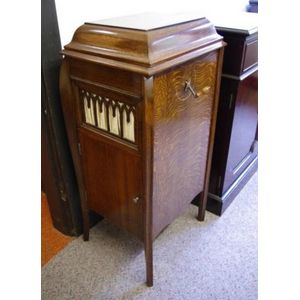
Rexonola Oak Gramophone with Needles and Stand
Rexonola oak case gramophone with tins of needles, 43 cm wide, 101 cm high
In the evolution of mechanical music, the gramophone followed the phonograph and the graphophone, each of which was invented in the United States. For the gramophone, the music was recorded on a flat disk, unlike the phonograph and graphophone. However in modern usage, the words "gramophone" and "phonograph" are both sometimes used to describe a gramophone or a gramophone record.
The phonograph was invented by Thomas Edison in 1877, and its major disadvantage was that, as well as the reproduction being poor, each cylinder lasted for only one play.
The graphophone was an improved version of the phonograph and went into commercial production in about 1885. Invented at the Volta Laboratory established by Alexander Graham Bell, it used wax cylinders which lasted for multiple plays. However each cylinder had to be recorded separately, preventing mass reproduction, and also resulting in differences in sound between each.
In 1887, Emile Berliner, a more...
1 item found:
These items have been sold, and the description, image and price are for reference purposes only.

Rexonola oak case gramophone with tins of needles, 43 cm wide, 101 cm high
 Loading more...
Loading more...